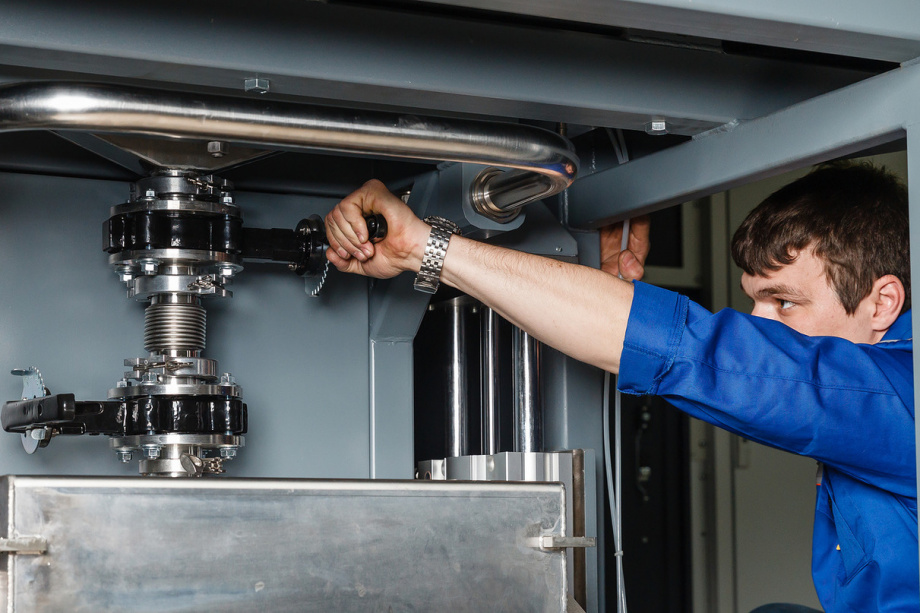
The first Russian-made industrial 3D printer with working chamber dimensions of 550х550 for metal products was presented by State Corporation Rosatom at the Innoprom-2016 industrial exhibition held in Yekaterinburg. The hardware and its software are a completely domestic development. With the series production of metallic powder 3D printers, the domestic industry will be able to transfer to a new stage — digital production, embracing the entire cycle ranging from design to output of a finished product.
The prototype model of the 3D printer was designed by the specialists of the RF State Research Center JSC CNIITMASH (with JSC Atomenergomash, part of the Rosatom Machine Building Division) jointly with the Rosatom Research Division (a managing company "Science and Innovations"). The device is equipped with a 1,000 W laser and a 3-axis scanning optical system. The predicted printing speed is 15 to 70 cm3/hr, matching the characteristics of foreign analogs.
"This project effort will involve to the utmost the relevant research and engineering potential of Rosatom and create a firm basis for further development of the entire machine-building sector. Ultimately, developing 3D printing of metal products will dramatically cut costs and production time, and as a whole will boost competiveness of Russian companies in the global market", commented Andrey Nikipelov, CEO of JSC Atomenergomash.
"Printing different objects with a 3D printer using layer-by-layer build-up is the so-called additive technology, which is being developed at Rosatom at an industrial level. Additive technologies make the production of complex-shape and critical parts cheaper, increase the quality characteristics of products and company competitiveness as a whole", said Aleksey Dub, First Deputy Director General of a managing company "Science and Innovations".
The printer uses the method of layer-by-layer selective laser melting (SLM). Metallic powders based on iron, titanium, aluminum, nickel, cobalt and others can be used as raw materials. "To obtain uniform layers, the powders should meet specific requirements to the spherical shape factor and flow rate. In this case, the particles will tightly fit the given volume and ensure required flow characteristics . The smaller the particles, the smaller the build-up step which can be set, with the smallest elements standing out better. Fortunately, such powders are being produced in Russia, and we will be independent of consumable materials", said Evgeni Tretiakov, Deputy Director for Planning and Production of the Institute for Surface and Nanomaterials Technologies of CNIITMASH.
CNIITMASH specialists also developed all the software for the Russian-made printer. The digital 3D model is made in CAD, followed by conversion to a working file. The proprietary software allows addressing all issues involving information security, industrial spying and the possibility of unauthorized data transfer.
Presently, the printer is operating in the semi-automatic mode, various systems are being tested, and optimal parameters of functioning of all device actuator assemblies are being selected. By the end of the year, all R&D efforts should be completed. Following this, the characteristics of products printed on the printer with different materials will be obtained and confirmed by investigation results. Giredmet and VNIIHT, parts of the Research Division, will be involved in producing complex composition powders, developing research programs and compiling regulatory support documents. This will be followed by a period of series production. Having available a prototype model, Rosatom specialists will have the opportunity of dealing more intensely with potential customers within the framework of further technology development. Note that the printer will cost much less than foreign-made machines. The price of a similar imported bare bones basic device is about 100 million roubles, whereas the domestic machine will cost twice less.
3D printing of metal products reduces dramatically production waste and increases production reliability. The method is more profitable than conventional production ones also because the time spent on R&D, making prototypes and the products per se is less by an order. The quality and the strength of the products obtained is not inferior to those of analogs, and in some cases even exceed them, for instance, those of cast products of the same complex shape.
Presently, major foreign and Russian companies are aggressively introducing additive technologies into production processes. Thus, Boeing uses 3D printing for annually producing over 22,000 parts of 300 descriptions for military and civil aircraft. General Electric has mentioned earlier that in ten years half of the parts will be made using 3D printing. As a whole, according to expert opinions, the volume of the global market of additive technologies and of all associated items (service, completing articles) will exceed 12 billion dollars in the nearest future.
